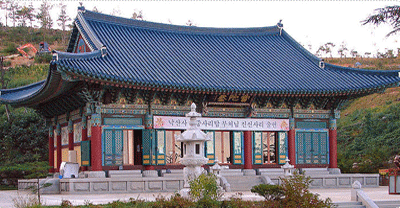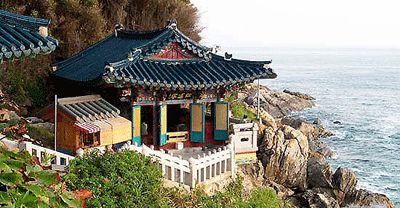Naksan Temple is a Korean Buddhist temple complex in the Jogye order of Korean Buddhism that stands on the slopes of Naksan Mountain (also called “Obongsan Mountain”). It is located about midway between Sokcho and Yangyang, Gawngwon Province, eastern region of South Korea. Naksansa is one of the few temples in Korea to overlook the Sea of Japan (East Sea).
Naksan is an abbreviated term of Botarakgasan in Korean to refers to “Potalaka Mountain”, the place where the Avalokitesvara Bodhisattva is believed to live. Thus, Naksan Mountain is also known as Korea’s Potalaka Mountain. The Bodhisattva is said to live on a sea-bound island along with guardian dragons. Naksansa is regarded as one of the great eight scenic areas in the Eastern region of Korea, known as “Gwandong Palgyeong”.
Naksansa was founded in 671, by the Buddhist monk, Uisang Daesa (Grand Master Uisang), an ambassador of the 30th King Munmu of the Silla Period (BC 57-AD 935) after he had returned from studying abroad during the Chinese Tang Dynasty, who, while meditating near the cave in which the Avalokitesvara Bodhisattva (Gwaneumbosal) was believed to have lived, was told by the Bodhisattva to build the temple there.
Today, the octagonal Uisangdae Pavilion sits on the spot where Uisang once meditated, the current pavilion having been built in 1925.
Mount Naksan is crowned by the Buddhist statue of Haesugwaneumsang, known as the goddess Gwanseum-Bosal, facing southeast standing 15 meters high on a 2.8-meter high pedestal. The white granite statue stands in a clearing at the top of the hill, eyes and fingers closed in peaceful meditation as it gazes out to sea. The massive statue is the work of Busan sculptor Gwon Jeong-hwan and was dedicated in 1977. 700 tons of granite and six months were required to complete the sculpture. It is the largest Buddhist statue of its kind in the Orient.
Hongreanam was built by Uisang as a Hermitage above a stone cave. In the sanctuary floor there is a 10-centimeter opening through which you can see the sea below.
Naksansa’s seven storied stone pagoda, Naksansa Chilcheung Seoktap (Seven storied stone pagoda in Naksansa Temple) built in 1467, the 13th year of the reign of King Sejo, is Treasure No.499. During a repair, it is said that a Buddhist rosary and a magic bead were sealed inside the pagoda. The seven storied stone pagoda is an example of the Goryeo style pagoda having a single square foundation. The square foundation on this pagoda is carved with 24 lotus petals. Of special note is a stone prop in each story, which is larger and thicker than its body stone. The pagoda is formed with thin eaves, a straight slope, and upward edges. On the finial, around the long thin, bronze rod are ornaments similar to those in Lama pagoda of Yuan Dynasty (1279-1368) in China. Mostly it follows the rather simple style of the Goryeo pagodas though.
Tel: 82-396-672-2448
Web: www.naksansa.org
(From: wikipedia)







Comments are closed.